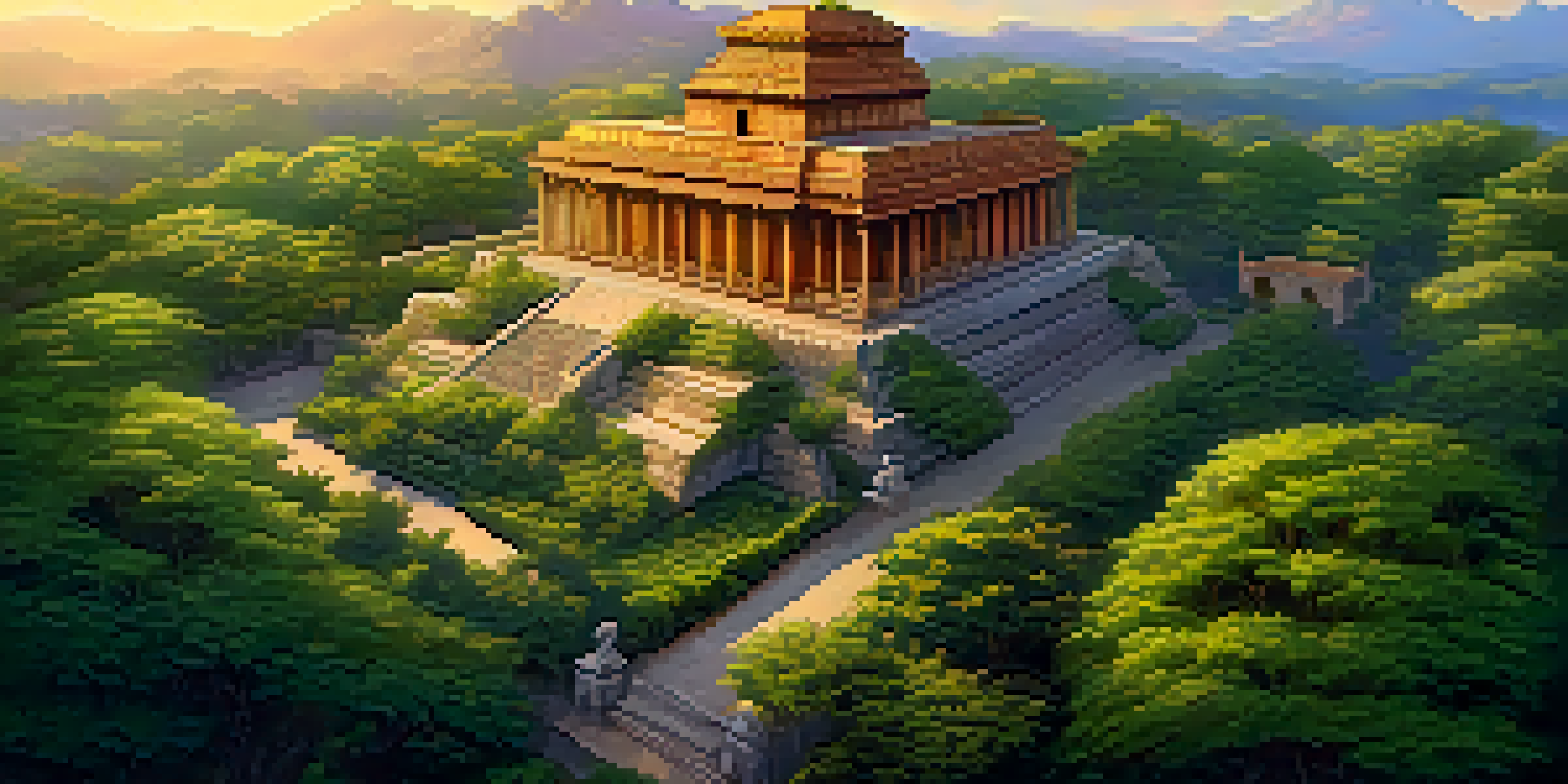Innovative Technologies in Heritage Site Conservation

The Role of 3D Scanning in Heritage Preservation
3D scanning technology has become a game changer in the field of heritage conservation. By creating detailed digital replicas of historical sites, conservators can monitor changes over time and plan restoration efforts more effectively. Imagine being able to revisit a site virtually, even if it undergoes physical changes due to weather or human activity.
Preservation is not an act of nostalgia; it’s a commitment to the future.
This technology allows for precise measurements and can capture intricate details that might be overlooked during traditional documentation methods. The data gathered can be invaluable for future research and education, ensuring that even the smallest features of a site are not lost to time. It’s like having a time capsule that can be opened and examined whenever needed.
Moreover, 3D models can enhance public engagement by providing interactive experiences. Visitors can explore a site’s history through virtual reality, making the past feel more tangible. This innovative approach helps to foster a deeper appreciation for heritage sites, encouraging more people to support conservation efforts.
Drones: A New Perspective on Site Monitoring
Drones have emerged as an essential tool in the monitoring and management of heritage sites. By providing aerial views, drones can help identify potential threats like erosion, vegetation encroachment, or even illegal excavations. This bird’s-eye perspective allows conservators to address issues before they escalate, much like a watchful guardian overseeing a precious treasure.

Additionally, drones equipped with high-resolution cameras can capture stunning images and videos that document the site’s condition over time. These visual records are crucial for both preservation planning and public awareness campaigns. Imagine being able to showcase the beauty and fragility of a heritage site with breathtaking aerial footage, inspiring more people to care about its future.
Tech Innovations in Heritage Conservation
Emerging technologies like 3D scanning, drones, and AI are revolutionizing how we preserve and monitor cultural heritage sites.
Furthermore, drone technology is continually evolving, with advancements in sensors and automation making them even more effective. As the technology becomes more accessible, we can expect to see drones playing an even larger role in heritage conservation efforts, revolutionizing how we monitor and protect our cultural treasures.
Virtual Reality: Immersive Experiences of History
Virtual reality (VR) is transforming the way we experience cultural heritage. By immersing users in a digitally recreated environment, VR allows people to explore historical sites as they might have appeared centuries ago. This engaging experience can spark curiosity and encourage a deeper understanding of a site’s significance.
Heritage conservation is not just about protecting the past; it’s about creating a better future for generations to come.
Imagine walking through the bustling streets of an ancient city or standing in awe before a magnificent temple, all from the comfort of your home. VR can bridge gaps in accessibility, enabling people who may never visit a site in person to appreciate its beauty and history. This technology can also enhance educational programs, allowing students to learn about history in an active, engaging way.
Moreover, VR can assist conservators in planning restoration projects by visualizing potential outcomes before any physical work begins. This foresight can lead to more thoughtful decisions about how to preserve the integrity of a site while making it accessible to future generations. In essence, virtual reality not only preserves history but also brings it to life.
Artificial Intelligence: Smart Solutions for Conservation
Artificial intelligence (AI) is making waves in heritage site conservation by analyzing vast amounts of data for predictive insights. For instance, AI algorithms can scan historical records, photographs, and past restoration efforts to identify patterns that may inform future conservation strategies. This data-driven approach allows for more targeted and efficient preservation efforts.
Consider how AI can help conservators prioritize which areas of a site need immediate attention based on predictive modeling. By assessing potential risks and deterioration rates, AI can be likened to having a knowledgeable assistant who helps guide decisions in a complex landscape. This technology not only saves time but also resources, ensuring that funds are allocated effectively.
Community Involvement in Preservation
Engaging local communities in conservation efforts fosters ownership and ensures preservation strategies align with their values.
Furthermore, AI can facilitate enhanced visitor experiences through personalized recommendations and smart guides. Imagine visiting a heritage site and receiving real-time information tailored to your interests, enriching your understanding as you explore. As technology continues to advance, the integration of AI in heritage conservation will undoubtedly pave the way for more innovative and sustainable practices.
Digital Documentation: Keeping History Alive
Digital documentation has revolutionized how we preserve historical records and artifacts. By converting physical documents into digital formats, we can safeguard valuable information against deterioration or loss. This process ensures that future generations have access to our cultural heritage, much like creating a backup of cherished family photos.
Moreover, digital archives can be easily shared and accessed globally, breaking down geographical barriers to knowledge. Imagine a student in a remote village having access to the same historical documents as a researcher in a bustling city. This democratization of information promotes a more inclusive understanding of history and heritage.
Additionally, digital platforms can facilitate collaborative efforts among researchers, conservators, and the public. Crowdsourcing initiatives allow individuals to contribute to the documentation process, fostering a sense of community around heritage preservation. This collective effort not only enriches the archive but also strengthens the bonds between people and their shared history.
Sustainable Practices: Balancing Preservation and Environment
As we embrace innovative technologies in heritage conservation, sustainability must remain a priority. Integrating eco-friendly practices into conservation efforts ensures that our cultural treasures are preserved without compromising the environment. This balance is essential for maintaining the integrity of both our heritage and the planet, much like a delicate dance between tradition and modernity.
For example, using sustainable materials and methods in restoration projects can minimize the ecological footprint. Techniques like using local stone or eco-friendly paints not only help maintain authenticity but also support local economies. This approach fosters a sense of stewardship, encouraging communities to take an active role in preserving their heritage.
Sustainable Practices for the Future
Integrating eco-friendly methods into conservation efforts is essential for balancing the preservation of cultural heritage with environmental responsibility.
Furthermore, the use of renewable energy sources in heritage sites can reduce operational costs while promoting environmental responsibility. Imagine a historic building powered by solar panels, blending modern technology with ancient architecture. By prioritizing sustainability, we can ensure that heritage sites continue to be a source of pride and inspiration for future generations.
Community Engagement: Involving Locals in Conservation Efforts
Community engagement is crucial in the realm of heritage conservation. Involving local residents in preservation efforts not only fosters a sense of ownership but also ensures that conservation strategies reflect the community's values and needs. Much like a family working together to maintain their home, communities that collaborate in conservation are more likely to cherish and protect their heritage.
For instance, local workshops can educate residents about the importance of preserving their cultural heritage while providing them with the skills to actively participate in restoration projects. This hands-on approach empowers individuals to take pride in their history and encourages intergenerational knowledge transfer. It’s a way of passing down stories and traditions while actively caring for the community's legacy.

Moreover, engaging communities in decision-making processes can lead to innovative solutions that might not have been considered otherwise. Local insights can help identify the most pressing issues and create targeted strategies for preservation. As we look to the future, fostering strong community connections will be vital for the long-term success of heritage site conservation.
The Future of Heritage Conservation: Embracing Change
As innovative technologies continue to evolve, the future of heritage site conservation looks promising. Embracing these advancements allows us to protect our cultural treasures in ways that were previously unimaginable. This journey towards modernization is akin to an artist experimenting with new mediums to create a masterpiece, blending tradition with innovation.
The integration of various technologies—like 3D scanning, drones, and AI—will create a holistic approach to conservation that is both effective and sustainable. By combining the best practices from different fields, we can develop comprehensive strategies that ensure the longevity of our heritage sites. Think of it as assembling a toolkit where each tool has its unique purpose but together creates a harmonious solution.
Ultimately, the success of these efforts will depend on collaboration among stakeholders, including governments, organizations, and communities. By working together and embracing change, we can ensure that our cultural heritage not only survives but thrives, inspiring future generations to appreciate and protect the stories of our past.